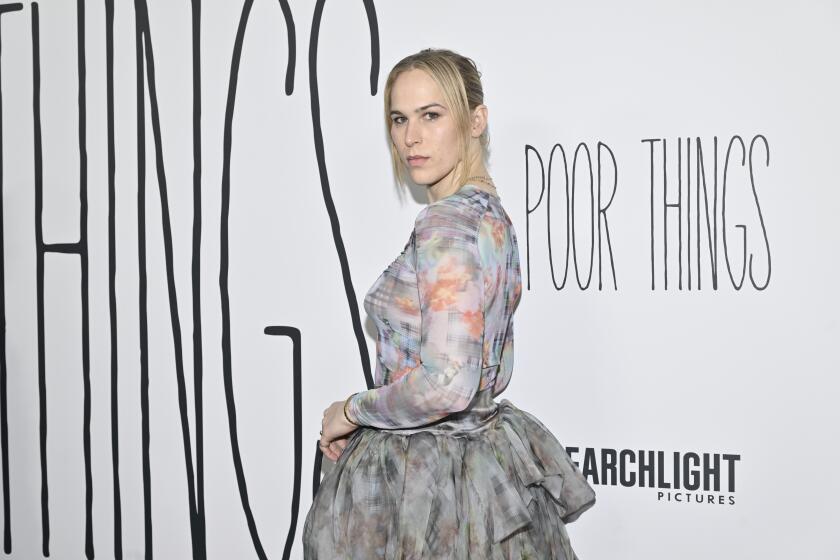Dissed and tsk tsk-ed
BECAUSE the Orange County rich have more money than the rest of us, they also have bigger and newer houses, cars, diamonds and breasts, according to the new reality show “The Real Housewives of Orange County.” The problem is what they don’t have, namely, any interest in being perceived as melon-breasted, jewel-encrusted, SUV-driving, margarita-sipping mansionistas. And that means trouble in Coto de Caza.
“I got flipped off the other day,” said “Housewives” creator Scott Dunlop, a businessman and actor who had been observing his neighbors in the resort-like development for 19 years before launching the show, his first as a television producer, on Bravo. The series follows five women and their families as they play tennis, play house, and work at getting ahead and staying young-looking.
“I was in the grocery store and a woman I know shook her head and tsk-ed me and looked away,” Dunlop added. Even before the show aired, he said he had been likened to Satan and had received whispered threats in midnight calls to his home, a luxurious multilevel place whose pool overlooks a golf course.
He’s not alone in being targeted. Kimberly Bryant, one of the featured “housewives” who has been seen working out while explaining that 85% of her female neighbors have had breast implants like hers, said onetime friends have dropped her. On Friday, one of her daughter’s classmates brought in a handmade poster that read “I hate ‘The Real Housewives of Orange County’ ” for an assignment. Even one of the teachers at the sectarian private school had taken Bryant’s 13-year-old aside to ask if she was ashamed to have her mom on the show, Bryant said.
The series, which has received mixed reviews (“a masterpiece”; “appalling”) has crystallized Orange County’s identity as home of the nouveau riche and their gorgeous, spoiled children, an image that developed on scripted shows “The O.C.” and “Arrested Development,” both largely shot in Los Angeles, and hit closer to home with MTV’s romanticized reality show, “Laguna Beach: the Real Orange County.”
“Housewives” exposes a different slice of the Orange -- the large-scale planned communities, such as Mission Viejo, Irvine and Newport Coast, common to south Orange County. Created all from scratch on rural, single-owner tracts, the communities are less suburban than exurban. And without local history or traditions, the social hierarchies that have arisen are based on a pretty straightforward formula: specific neighborhoods’ av-erage square footage. (In one episode, divorced dad Slade Smiley fails to impress a potential client by dropping the name of his neighborhood; the client counters with his own, more exclusive neighborhood in Coto.)
Dunlop said his original idea was to create a scripted/unscripted satire called “Behind the Gates” looking askance at life in Coto, a 4,400-home, 5,000-acre development bordering the Cleveland National Forest. The guard-gated community includes 3,000-square-foot homes as well as 50-acre compounds and gated homes. There are tennis courts, riding trails and two golf courses. According to census figures, residents are 89% white. (Notable exception: Snoop Dogg, who reportedly owns a home there.)
Dunlop wanted to base one character on a real neighbor who works on what he called the “15-15 plan.” “He works 15 minutes a day for 15 years and makes over a million bucks a year,” he said.
In a way, those who buy into the developments seem to mirror the place itself -- insular, pleasant and obsessed with youth. (“In Orange County, people just don’t grow old,” notes Lauri Waring, the show’s Botoxed divorced mom.) Residents work hard to control their images -- and never so much as when it might appear that their images are controlling them.
Though the characters strike a familiar note, other moms in Coto said they don’t like to be associated with what they said were false images. Debra Douglass, 32, president of MOMS (Mothers Offering Mothers Support) Club of Coto de Caza, a support group for stay-at-home mothers, said she doesn’t wear makeup to the gym and estimated that only 1% of MOMS Club members have implants. “They portray the women to be very superficial,” she said. “Most people who live here are real people raising kids, working hard.”
One resident, who did not want to be identified, said the Los Angeles rich are equally materialistic, just not as conspicuous. Status in L.A. tends to revolve more around which private school your child is in, she said. (As in “Laguna Beach,” schooling appears to be an afterthought in “Housewives.”) Besides, she said, Coto de Caza isn’t the richest place in the county. “Newport Coast is worse,” she said.
Needless to say, most said they would be watching the rest of the series.
Actually, most of the “housewives” are independent working women. One is single; one is engaged to and living with Slade, the devoted father of two boys. Bryant, the only stay-at-home, is shown letting her hair down only when she gets outside the gates, on a raucous trip to Vegas with some girlfriends.
Still, some residents were shocked to see the show’s depiction of parents giving their kids new luxury cars, or $500 for making varsity. The first season’s seven episodes, which will end May 2, feature backyard rabbit hunting, a diamond-shopping party, and lusty teen boys explaining a crass acronym for the most attractive moms in the neighborhood. “If you hook up or anything with a mom, you’re the man,” Shane Keough, 18, is heard via voice-over in an episode in which he demonstrates rabbit hunting to Jo, Slade’s fiancee.
On the positive side, Douglass said, the show might serve as a cautionary tale for some residents, particularly in how not to spoil children. JoAnn Wright, who sells real estate in Coto but lives in nearby Mission Viejo, said watching the troubles of the wealthy (one child goes to juvenile hall, others have no interest in working or studying) made her happier with her own, less affluent life.
Dunlop, a former Groundlings actor, said his goal was to bring Orange County content, using Orange County talent, to the Los Angeles-dominated TV industry. A tall, talkative man in jeans and a black T-shirt, Dunlop said he realized about eight years ago that his business ventures -- owning an ad agency and being a partner in a bio-energy company -- weren’t enough to satisfy his creative drive.
He sold his idea to Bravo two years ago, just as “Desperate Housewives” and reality shows were taking off. Hoping to capitalize on the trends, network executives changed the title and concept to straight reality, he said.
Early rumors that a reality show would be filmed in the community stirred up passionate opposition. Some worried that a negative image could drive down property values, according to C.J. Klug, general manager of the homeowners association in Coto de Caza. As concessions, the show’s producers agreed not to mention Coto de Caza by name or show any of the common areas.
Dunlop recalled a man at a homeowners meeting saying the thought of the project made him so sick, he wished he had a 50-gallon bucket to hold his own vomit. Another suggested Dunlop and Michael Moore should go to Baghdad and film roadside explosions.
Neighbors who still speak to Dunlop have questions. Why is he doing this here? Why did he pick these women to represent Coto de Caza? Why does he want to put this on TV? Why doesn’t he do good programming?
Dunlop said the women were chosen to represent themselves, not the community. “What was important to us was to find the story elements in their lives to connect, so you have a beginning, a middle and an end. We took the documentary format and collapsed it into a soap.”
The point he thinks his neighbors will understand is, “We’re a business model. The business model is to produce programs that people watch. If we’re going to get into the debate on why don’t you do elegant programming, fine, I’d love to do more of that. We need to do commercial things first.”
He said he never expected that the show would have psychological ramifications, exaggerating some of the participants’ emotions in front of the camera or stirring up hard feelings in the community. (Producers turned off the cameras when one couple’s arguments became too intense; one father’s arrest for drunk driving was never included, at his and his lawyer’s request.)
One woman in the community called him to ask why he had one of the housewives tell another to bring a straw to the tennis courts so she could drink without smearing her lipstick. (“That’s the kind of stuff I love,” he said.)
Bryant said she too has been surprised by the intensity of the criticism. Her philosophy of “being generous to those who judge you” has been tested more than ever before, she said. She said she understands that the series shows only one of her many sides. “The show is a kick in the pants. It’s fun and frivolous and keeps your mind off your real problems,” she said. Some scenes follow Bryant as she undergoes a biopsy for recurrent skin cancer.
“Honestly, I think there are a lot of people who even though they appear to be successful on the outside can’t laugh at themselves. They’re afraid television says something about them, or doesn’t and wish it did,” Bryant said.
Besides the criticism, the cast is starting to enjoy some of the perks of fame. Smiley (his real name), a title insurance executive, knew there could be business benefits to appearing on the show. One potential client, Brent McElwee, chief executive of American Home Loans and another Coto de Caza resident, was shown as unimpressed with Smiley’s sales pitch on the show. But Smiley said he ran into him again at the premiere and pitched him again. “We’ll have that conversation,” he said. “It would not have happened were it not for the show.”
A week before the premiere, Smiley’s fiancee, Jo De La Rosa, 24, was pictured in a local ad for her employer, a mortgage lender, both in a business suit and in her slinky “Housewives” dress.
Through the show’s ups and downs, cast members have become close friends, Bryant said. “The five women get together once a week, have a meal and a chitty chat.” Most agree they would do it again if the show is picked up for a second season.
Though Dunlop would love to do a second season, he said, “I don’t know if we’ll do it here.” He said he’s going to New York in a few weeks with an idea for a new show. This one, he said, is about “a group of ladies from La Jolla.”
The complete guide to home viewing
Get Screen Gab for everything about the TV shows and streaming movies everyone’s talking about.
You may occasionally receive promotional content from the Los Angeles Times.



